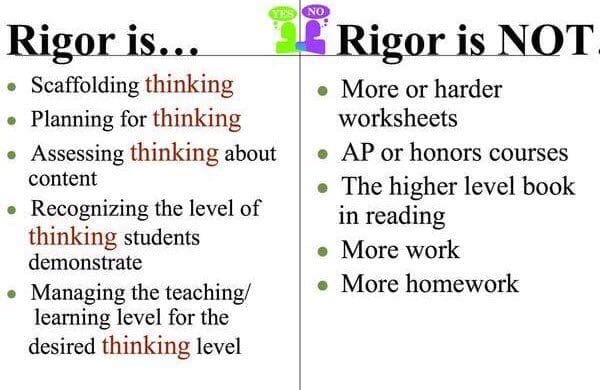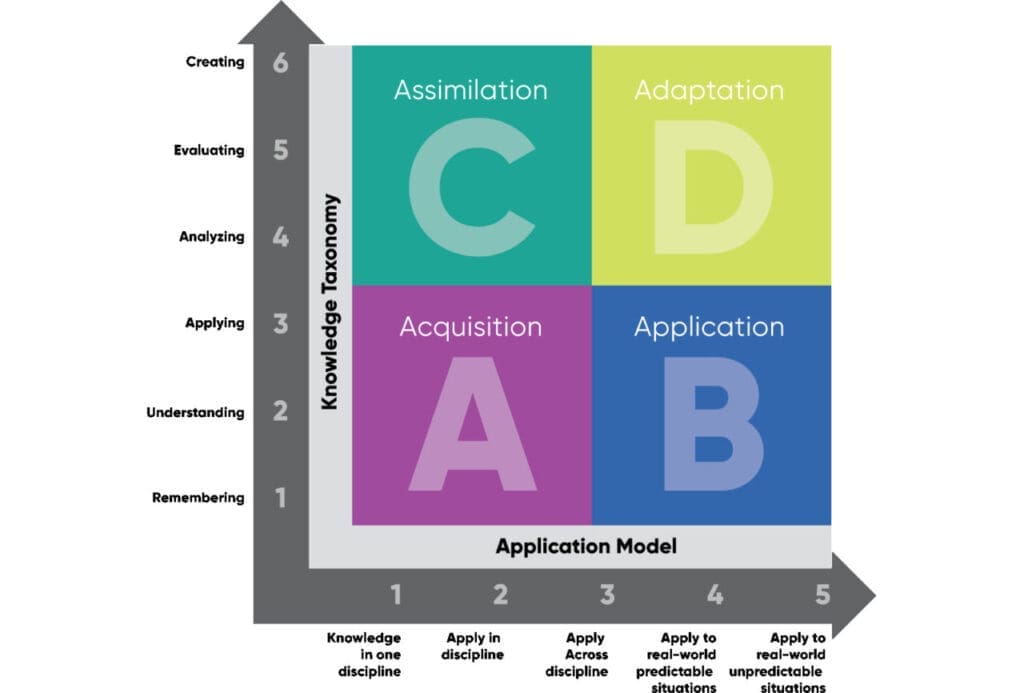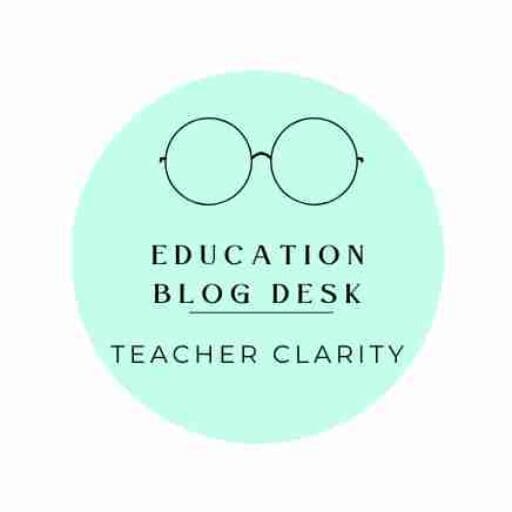
Key Highlights
- Unlocking Power of Rigor explores the essential concepts that drive a rigorous education.
- Uncover the value of rigor in education, including the key components that enhance its effectiveness and foster a stimulating learning atmosphere.
- We’ll dive into the role of high expectations and genuine assessments, examining the approaches that inspire students to engage in critical thinking, tackle problems, and put their knowledge to use.
What is Rigor?
To understand how rigor can make learning soar, we first delve into its defintion
Author of A New Definition of Rigor article, Brian Sztabnick cites David Foster Wallace, a novelist, definition of rigor:
“Rigor is the result of work that challenges students’ thinking in new and interesting ways. It occurs when they are encouraged toward a sophisticated understanding of fundamental ideas and are driven by curiosity to discover what they don’t.”
This is a fresh perspective on rigor in education moves beyond just tough content and heavy loads. This highlights the importance of experiences that stimulate students’ thinking in creative and engaging ways, fostering a deep grasp of essential concepts fueled by curiosity. The goal is to cultivate a supportive environment in which students are encouraged to learn actively and showcase their understanding at advanced levels.
What Academic Rigor Means:
Here is a breakdown of what rigor means based on A New Defintion article:
- High Expectations: Rigor involves setting high expectations for all students and providing them with the support and resources they need to succeed.
- Beyond Surface Learning: Rigor moves beyond rote memorization and simple recall, aiming for deeper understanding and application of knowledge.
- Challenging and Engaging: It involves creating a learning environment that is both challenging and engaging, fostering student curiosity and intellectual growth.
- Critical Thinking and Problem Solving: Rigorous instruction encourages students to think critically, analyze information, and solve complex problems.
- Real-World Application: Rigor emphasizes the application of knowledge to real-world situations, helping students see the relevance of their learning.
Having established what rigor entails, we now turn to its broader impact on educational outomes.
The Role of Rigor in Education
The significance of rigor in broad educational outcomes lies in its ability to foster deep, meaningful learning and prepare students for academic, professional, and personal success. Here are the key ways rigor impacts educational outcomes:
1. Promotes Critical Thinking and Problem-Solving
Rigor challenges students to engage in higher-order thinking, such as analyzing, evaluating, and creating. This equips them with the cognitive skills needed to tackle complex problems in various contexts, from academics to real-world situations.
2. Encourages Lifelong Learning
By emphasizing inquiry-based and reflective learning, rigor helps students develop habits of curiosity and perseverance. These traits are essential for adapting to new challenges and opportunities throughout life.
3. Prepares Students for Future Success
Rigorous education aligns with the demands of college, careers, and civic life by teaching students to handle ambiguity, synthesize information, and apply knowledge creatively. This ensures they are well-prepared for future academic and professional endeavors.
4. Enhances Motivation and Engagement
When students see purpose in their learning—through relevant, authentic tasks—they are more motivated to invest effort. Rigor fosters a sense of accomplishment as students meet high expectations with appropriate support.
5. Reduces Educational Inequities
Rigor promotes equity by holding all students to high standards while providing the necessary support to meet those expectations. This approach helps close achievement gaps and ensures all learners have access to meaningful educational experiences.
6. Builds Resilience and Grit
Through rigorous tasks that require sustained effort and persistence, students develop resilience and grit. These qualities are critical for overcoming challenges both inside and outside the classroom.
Rigor is essential for cultivating well-rounded learners who are capable of critical thinking, adaptable to change, and prepared for future success in a complex world. It not only enhances individual achievement but also contributes to broader societal progress by fostering equity and innovation.
Key Elements of Rigor in Education
Rigor in education is characterized by thoughtfully designed learning experiences that challenge students to think deeply, engage in high-level questioning, and participate in meaningful academic discussions. Rather than simply increasing the quantity of work or making assignments harder, rigor focuses on the complexity and depth of understanding required from students. Key elements include setting high expectations for all learners, supporting them to reach those expectations, and providing opportunities for students to demonstrate their learning in multiple ways. Rigorous classrooms encourage critical thinking, problem-solving, and creativity, often through tasks that require students to analyze, synthesize, and apply knowledge rather than just recall facts. Additionally, rigor involves making learning relevant and authentic, connecting content to real-world situations and students’ own experiences. Strong relationships and a supportive environment are also essential, as they empower students to take academic risks and persist through challenges, ultimately leading to deeper mastery and meaningful growth. In addition, encouraging students to take ownership of their learning by providing opportunities for choice, voice, and self-directed tasks fosters deeper engagement and independence (student autonomy).
A practical tool for applying these principles of rigor is the Rigor Relevance Framework.
Rigor Relevance Framework
The Rigor/Relevance Framework is a tool designed to enhance curriculum, instruction, and assessment by integrating challenging academic standards (rigor) with real-world application (relevance). Developed by the International Center for Leadership in Education, it combines two dimensions: the Knowledge Taxonomy, based on Bloom’s Taxonomy, and the Application Model, which focuses on applying knowledge in various contexts.
The Knowledge Taxonomy, specifically Bloom’s Taxonomy, is a framework that organizes learning into levels of complexity and depth. It helps educators structure lessons, objectives, and assessments to guide students through progressively challenging cognitive tasks. Think of it as a ladder where each step builds on the previous one.
- Remembering: At the base, students recall facts or basic information, like memorizing vocabulary.
- Understanding: Students explain concepts or summarize ideas, such as paraphrasing a story.
- Applying: Knowledge is used in practical situations, like solving math problems.
- Analyzing: Students break down information into parts to see relationships, such as comparing two characters in a book.
- Evaluating: They make judgments based on criteria, like critiquing an argument.
- Creating: At the top, students design new ideas or solutions, such as writing an original essay or building a model.
This hierarchy ensures learners progress from foundational knowledge to advanced thinking and problem-solving.
The Rigor/Relevance framework is divided into four quadrants:

- Quadrant A (Acquisition): Students recall and understand basic knowledge, such as memorizing facts or definitions.
- Quadrant B (Application): Students apply knowledge to practical, real-world situations, like solving predictable problems.
- Quadrant C (Assimilation): Students engage in higher-order thinking, such as analysis or synthesis, but within a single discipline.
- Quadrant D (Adaptation): Students use complex thinking to solve interdisciplinary, unpredictable real-world problems.
For example, in Quadrant A, students might identify types of angles. In Quadrant D, they could design a structure requiring precise angle measurements for stability. This framework ensures students not only master academic content but also learn how to apply it effectively in life.
Now, we will look at some strategies that you can use in the classroom.
Rigor Implementation Strategies
Here are effective strategies for implementing rigor in the classroom, based on best practices and research:
1. Build Strong Relationships
- Establish trust and rapport with students to create a safe learning environment where they feel supported to take on challenges.
- Students are more likely to engage in rigorous tasks when they believe their teacher cares about their success.
2. Differentiate Instruction
- Tailor tasks to meet students at their individual skill levels while maintaining high expectations for growth.
- Provide scaffolding and personalized challenges to ensure all students can engage in rigorous learning without becoming overwhelmed.
3. Incorporate Student Choice
- Allow students to select topics, projects, or methods of demonstrating learning that align with their interests and strengths.
- Choice fosters ownership, motivation, and deeper engagement with challenging material.
4. Use Project-Based Learning (PBL)
- Design open-ended, real-world projects that require critical thinking, creativity, and problem-solving.
- PBL encourages interdisciplinary learning and authentic application of knowledge.
5. Maintain High Expectations
- Set clear, consistent standards for effort and quality of work. Emphasize continuous improvement rather than just task completion.
- Encourage students to persevere through difficult tasks by providing constructive feedback and celebrating progress.
6. Focus on Relevance
- Connect lessons to real-world applications, current events, or students’ personal experiences.
- Relevant content motivates students to engage deeply with challenging material by demonstrating its value.
7. Promote Higher-Order Thinking
- Incorporate activities that require analysis, evaluation, synthesis, and problem-solving.
- Use Bloom’s Taxonomy or the Depth of Knowledge (DOK) framework to design tasks that challenge students cognitively.
8. Scaffold Complex Tasks
- Break down large assignments into manageable steps with intermediate deadlines.
- Provide guidance and practice at each stage to help students build confidence and skills for tackling rigorous work.
9. Encourage Reflection and Metacognition
- Ask students to reflect on their learning process, identify challenges, and develop strategies for improvement.
- Metacognitive practices help students take ownership of their growth and persist through difficulties.
10. Integrate Academic Discussions
- Facilitate meaningful discussions where students analyze ideas, justify opinions, and collaborate on solutions.
- Academic discourse promotes deeper understanding and critical thinking.
By combining these strategies, educators can create a classroom environment that balances high expectations with the support needed for all students to succeed in rigorous learning experiences.
The Relationship Between Rigor and Assessment
Rigor and assessment work together to ensure high-quality education:
- Alignment: Assessments should match the rigor of the instruction. If students are expected to engage in higher-order thinking, assessments must evaluate those skills rather than surface-level knowledge.
- Differentiation: While the standards remain consistent for all students, assessments can be adapted to meet diverse needs without compromising rigor. This ensures equity while maintaining high expectations.
- Feedback Loop: Assessments provide data that help educators refine their teaching strategies and adjust the level of rigor to better support student learning.
Academic Rigor Examples
Examples of academic rigor include:
Classroom Practices:
- Higher-Order Thinking Questions: Instructors should ask questions that go beyond simple recall, prompting students to analyze, evaluate, and synthesize information, according to Baylor University.
- Problem-Solving Activities: Engaging students in real-world problems and challenging scenarios allows them to apply their knowledge and develop critical thinking skills, says The Teachers Academy.
- Collaborative Work: Group projects and discussions encourage students to learn from each other, develop communication skills, and work towards a common goal.
- Complex Text: Exposure to challenging and varied reading materials promotes critical thinking and expands students’ knowledge base.
- Experiential Learning: Hands-on activities and real-world experiences allow students to apply theoretical knowledge and develop practical skills, according to Kent State University.
- Inquiry-Based Learning: Encouraging students to ask questions, explore topics, and conduct research fosters a deeper understanding of the material.
- Scaffolding: Providing structured support and guidance as students progress through increasingly challenging tasks allows them to build confidence and develop their skills. Check out my post How to be Strategic wth Scaffolding Related to DOK
